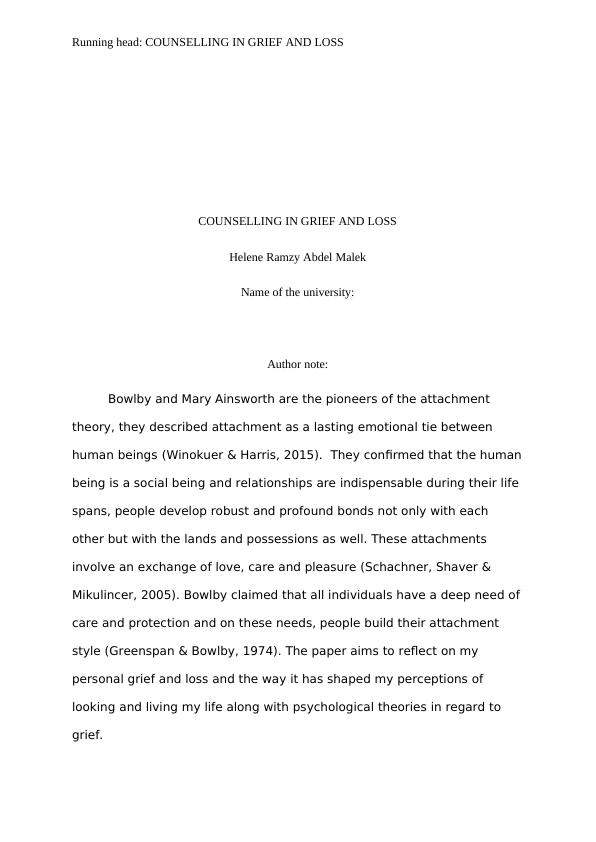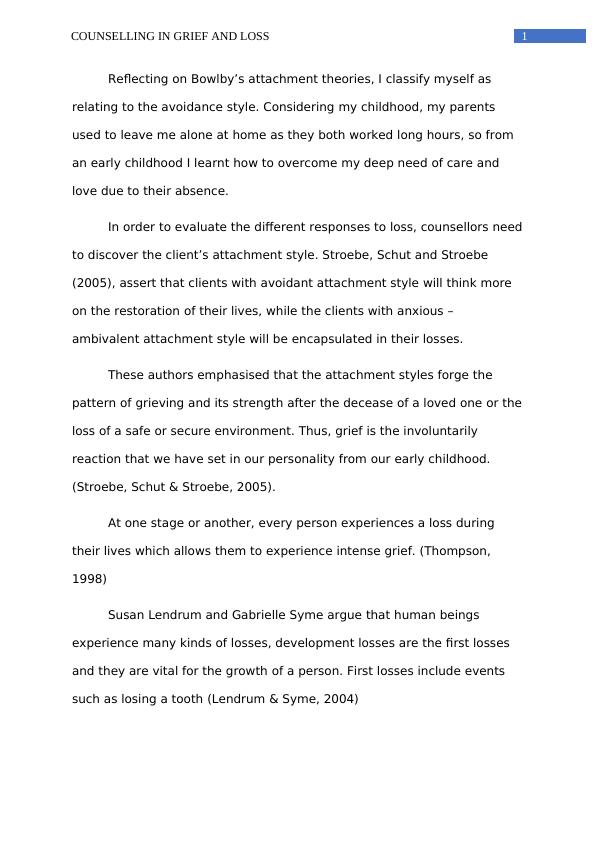Counselling in Grief and Loss
Added on 2023-01-19
16 Pages3778 Words87 Views
Running head: COUNSELLING IN GRIEF AND LOSS
COUNSELLING IN GRIEF AND LOSS
Helene Ramzy Abdel Malek
Name of the university:
Author note:
Bowlby and Mary Ainsworth are the pioneers of the attachment
theory, they described attachment as a lasting emotional tie between
human beings (Winokuer & Harris, 2015). They confirmed that the human
being is a social being and relationships are indispensable during their life
spans, people develop robust and profound bonds not only with each
other but with the lands and possessions as well. These attachments
involve an exchange of love, care and pleasure (Schachner, Shaver &
Mikulincer, 2005). Bowlby claimed that all individuals have a deep need of
care and protection and on these needs, people build their attachment
style (Greenspan & Bowlby, 1974). The paper aims to reflect on my
personal grief and loss and the way it has shaped my perceptions of
looking and living my life along with psychological theories in regard to
grief.
COUNSELLING IN GRIEF AND LOSS
Helene Ramzy Abdel Malek
Name of the university:
Author note:
Bowlby and Mary Ainsworth are the pioneers of the attachment
theory, they described attachment as a lasting emotional tie between
human beings (Winokuer & Harris, 2015). They confirmed that the human
being is a social being and relationships are indispensable during their life
spans, people develop robust and profound bonds not only with each
other but with the lands and possessions as well. These attachments
involve an exchange of love, care and pleasure (Schachner, Shaver &
Mikulincer, 2005). Bowlby claimed that all individuals have a deep need of
care and protection and on these needs, people build their attachment
style (Greenspan & Bowlby, 1974). The paper aims to reflect on my
personal grief and loss and the way it has shaped my perceptions of
looking and living my life along with psychological theories in regard to
grief.

1COUNSELLING IN GRIEF AND LOSS
Reflecting on Bowlby’s attachment theories, I classify myself as
relating to the avoidance style. Considering my childhood, my parents
used to leave me alone at home as they both worked long hours, so from
an early childhood I learnt how to overcome my deep need of care and
love due to their absence.
In order to evaluate the different responses to loss, counsellors need
to discover the client’s attachment style. Stroebe, Schut and Stroebe
(2005), assert that clients with avoidant attachment style will think more
on the restoration of their lives, while the clients with anxious –
ambivalent attachment style will be encapsulated in their losses.
These authors emphasised that the attachment styles forge the
pattern of grieving and its strength after the decease of a loved one or the
loss of a safe or secure environment. Thus, grief is the involuntarily
reaction that we have set in our personality from our early childhood.
(Stroebe, Schut & Stroebe, 2005).
At one stage or another, every person experiences a loss during
their lives which allows them to experience intense grief. (Thompson,
1998)
Susan Lendrum and Gabrielle Syme argue that human beings
experience many kinds of losses, development losses are the first losses
and they are vital for the growth of a person. First losses include events
such as losing a tooth (Lendrum & Syme, 2004)
Reflecting on Bowlby’s attachment theories, I classify myself as
relating to the avoidance style. Considering my childhood, my parents
used to leave me alone at home as they both worked long hours, so from
an early childhood I learnt how to overcome my deep need of care and
love due to their absence.
In order to evaluate the different responses to loss, counsellors need
to discover the client’s attachment style. Stroebe, Schut and Stroebe
(2005), assert that clients with avoidant attachment style will think more
on the restoration of their lives, while the clients with anxious –
ambivalent attachment style will be encapsulated in their losses.
These authors emphasised that the attachment styles forge the
pattern of grieving and its strength after the decease of a loved one or the
loss of a safe or secure environment. Thus, grief is the involuntarily
reaction that we have set in our personality from our early childhood.
(Stroebe, Schut & Stroebe, 2005).
At one stage or another, every person experiences a loss during
their lives which allows them to experience intense grief. (Thompson,
1998)
Susan Lendrum and Gabrielle Syme argue that human beings
experience many kinds of losses, development losses are the first losses
and they are vital for the growth of a person. First losses include events
such as losing a tooth (Lendrum & Syme, 2004)

2COUNSELLING IN GRIEF AND LOSS
Likewise, losses can be functional, like losing vision or hearing, or
interpersonal like social losses due to persecution, or changes of identity
associated to widowhood (Worden, 2018).
According to Kubler-Ross and Kessler (2014), explained that the five
stages of grief are tools that help people to understand what they may
encounter in their loss events, however they are not linear timeline in
grief. Grief is a personal journey; each person experiences it differently
(Gross, 2015).
Losses usually hold deprivations. Primary losses are the main losses
that happen in our lives, the consequences of these primary losses are
known as secondary losses not because they are less important but
because they are the results of the main losses such as loss of guidance,
loss of income and loss of support system (Winokuer & Harris, 2015).
In my life, I experienced many losses, losing my husband at a young
age was my biggest loss. I was 29 years old and my two kids were 18
months and 3 years old. Greenspan and Bowlby (1974) stated that the
loss of an attachment figure usually affects the development of the
assumptive world any individual would form when they were young.
I assumed when I got married that I will have a life like every other
ordinary housewife, and I will have control over my life, that is why the
death of my husband shocked me, and I was very anxious. I experienced
Weenolsen’s claim that after the death of a beloved one people may feel
that they don’t have control over their lives as before this event, they are
no more sure of what will happen in the future as the change of role in the
Likewise, losses can be functional, like losing vision or hearing, or
interpersonal like social losses due to persecution, or changes of identity
associated to widowhood (Worden, 2018).
According to Kubler-Ross and Kessler (2014), explained that the five
stages of grief are tools that help people to understand what they may
encounter in their loss events, however they are not linear timeline in
grief. Grief is a personal journey; each person experiences it differently
(Gross, 2015).
Losses usually hold deprivations. Primary losses are the main losses
that happen in our lives, the consequences of these primary losses are
known as secondary losses not because they are less important but
because they are the results of the main losses such as loss of guidance,
loss of income and loss of support system (Winokuer & Harris, 2015).
In my life, I experienced many losses, losing my husband at a young
age was my biggest loss. I was 29 years old and my two kids were 18
months and 3 years old. Greenspan and Bowlby (1974) stated that the
loss of an attachment figure usually affects the development of the
assumptive world any individual would form when they were young.
I assumed when I got married that I will have a life like every other
ordinary housewife, and I will have control over my life, that is why the
death of my husband shocked me, and I was very anxious. I experienced
Weenolsen’s claim that after the death of a beloved one people may feel
that they don’t have control over their lives as before this event, they are
no more sure of what will happen in the future as the change of role in the

3COUNSELLING IN GRIEF AND LOSS
family system will destroy all dreams and future plans, and that a deep
change has occurred in their personalities, they cannot go back to their
original selves prior to the loss (Weenolsen, 1988).
Within the main loss of my husband, I experienced other losses as a
result of my widowhood. Firstly, my role in the family changed, I became
the main source of income which is the secondary loss as mentioned
above, I had to work long hours to support my family. Socially, I became
single so I was excluded from almost every event held for couples. My
friends began to visit me without their husband unlike the way they used
to do earlier. While I needed to adapt to my conjugal broken bond, I found
that I suffer not only from an emotional loneliness but a social loneliness
as well.
According to Raphael (1984), grief can be defined as being the
emotions that accompany loss, and described it as a combination of
anger, sorrow, weakness, blame and hopelessness. Grief transforms
peoples’ lives as it helps to overcome sadness, loneliness and the
emptiness however in some way or the other eventually make the person
cope with the loss.
Many scholars claimed that the grieving process is displayed
through stages, phases and tasks. They argued that even if time is
considered as having an effective power of healing, still the person who
grieve needs to do something to overcome this period in life. (Gross,
2015)
family system will destroy all dreams and future plans, and that a deep
change has occurred in their personalities, they cannot go back to their
original selves prior to the loss (Weenolsen, 1988).
Within the main loss of my husband, I experienced other losses as a
result of my widowhood. Firstly, my role in the family changed, I became
the main source of income which is the secondary loss as mentioned
above, I had to work long hours to support my family. Socially, I became
single so I was excluded from almost every event held for couples. My
friends began to visit me without their husband unlike the way they used
to do earlier. While I needed to adapt to my conjugal broken bond, I found
that I suffer not only from an emotional loneliness but a social loneliness
as well.
According to Raphael (1984), grief can be defined as being the
emotions that accompany loss, and described it as a combination of
anger, sorrow, weakness, blame and hopelessness. Grief transforms
peoples’ lives as it helps to overcome sadness, loneliness and the
emptiness however in some way or the other eventually make the person
cope with the loss.
Many scholars claimed that the grieving process is displayed
through stages, phases and tasks. They argued that even if time is
considered as having an effective power of healing, still the person who
grieve needs to do something to overcome this period in life. (Gross,
2015)

End of preview
Want to access all the pages? Upload your documents or become a member.
Related Documents
Attachment Theory and the Impact of Loss: A Personal Perspectivelg...
|7
|2232
|78
Grief and Loss Theories Models and Scenario Applicationlg...
|12
|2937
|47
Counseling and Loss: Personal Experience and Professional Practicelg...
|9
|2736
|416
Moral Development: Types of Attachment and Their Influencelg...
|7
|1750
|55
